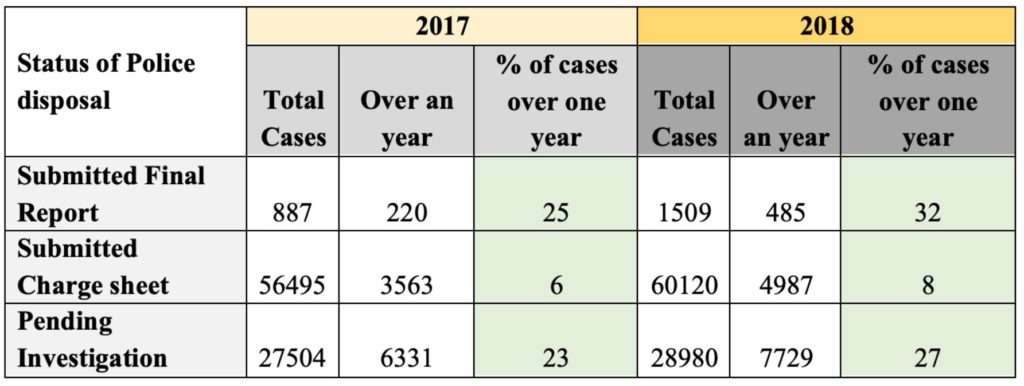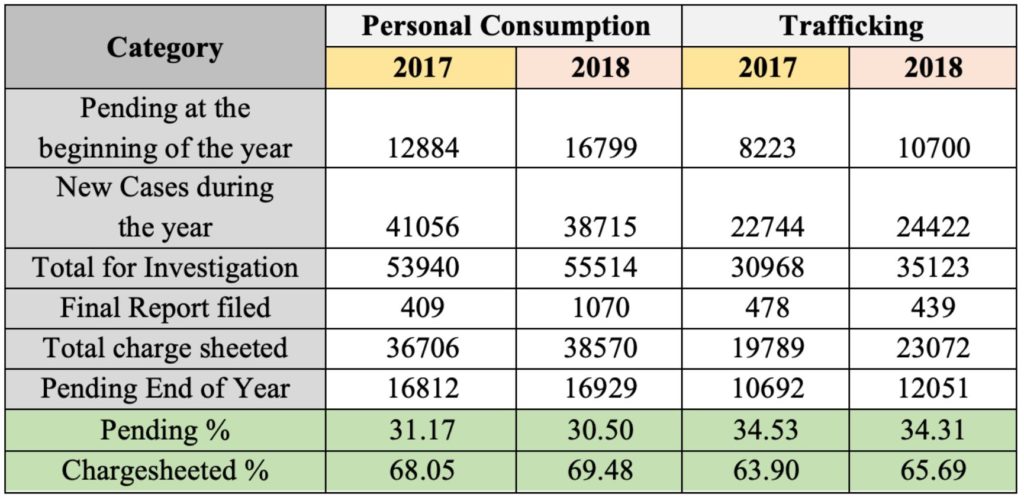Data from NCRB indicates that while there is a decrease in the proportion of NDPS cases nationally where the police investigation is complete, the same in metro cities has increased. However, the proportion of long-standing cases waiting to be charge sheeted has also increased.
In the earlier story, we analysed the trends in cases booked under the NDPS Act. While registration of cases under the act is one part of implementation of the law, another critical aspect is investigation and disposal of these cases, both by the law enforcing authorities i.e. police and the courts. In this story, we take a look at the trends of disposal of these cases by the police.
As in the earlier story, the data related to disposal of cases by police is taken from NCRB’s (National Crime Record Bureau) annual Crime in India reports.
Percentage of cases pending with the police has fallen over five-year period
The total number of cases being investigated by the police every year has increased during the five-year period of 2014 to 2018. In 2014, there were around 65 thousand cases to be investigated, which has increased continuously except for 2016, with more than 90 thousand cases pending to be investigated at the beginning of 2018. The increase in the number of cases to be investigated can be attributed to the increase in the number of new cases. With the exception of 2017 and 2018, the number of cases pending at the end of year have reduced during 2014 to 2016.
The cases disposed by the police can be broadly categorized into –
- Closed at their end and final report filed
- Charge sheet filed and case moves to the courts.
The trend pertaining to ‘cases closed by police and final report filed’ varied over the years and this number is significantly smaller than the number of cases wherein the charge sheet is filed, and the case is now pending with the courts.
Apart from the increase in the number of cases where a charge sheet is filed, even the proportion of total cases where a charge sheet is filed by the police has also increased. In 2014, around 60% of the cases were charge sheeted, which increased to around 66% by 2018.
With the increase in the proportion of cases charge sheeted by the police, the proportion of cases pending at the police has also come down, despite a marginal increase in the number of pending cases from 2014 to 2018.
At the end of 2014, 39% of the cases that were being investigated by the police were pending. It fell sharply to 31.7% and 30% in the subsequent years. Despite an increase in 2017, it has again fallen in 2018 to 31.97%.
More than 1/4th of the cases with police are pending for over a year
At the end of 2018, there were a total of 28,980 cases pending with the police that were registered under NDPS Act. Out of these pending cases, 1053 cases are pending for more than three years while another 6,676 cases are pending between 1-3 years. Only about 41% of these pending cases were pending for less than 6 months. In 2017, 23% of the cases were pending for investigation for over a year.
The proportion of cases which took over a year for ‘Submitting Final Report’ and ‘Submitting Charge sheet’ have also increased in 2018 compared to that of 2017. This points to an increasing delay at each of the stages. This could be due to the increasing number of cases.

Pendency rate at the Police has increased in Metro cities
NCRB’s Crime in India report provides data for 19 major cities in the country. The new cases reported in these major cities are around 1/3rd of the national numbers. However, in contrast to the trend observed with the nationwide numbers, the proportion of pending cases out of the total cases being investigated by the police has increased in 2018, compared to that of 2016.
In 2016, the proportion of pending cases was 27% which increased to nearly 39% in 2018. Correspondingly, the proportion of cases in these Metro cities, for which the police has filed a charge sheet has reduced. In 2016, nearly 73% of the cases taken up for investigation were charge sheeted, while in 2018 it fell down to 61%.
During the period 2016 to 2018, the number of cases pending with police has increased by nearly 50% without a substantial rise in the total number of cases being investigated every year.
Improvement in the proportion of cases pending investigation among those booked for personal consumption
Out of the total number of new cases booked in 2018, there was a decrease in those booked for possession of drugs for personal use. This along with the increase in the number of cases being charge sheeted has helped in reducing the proportion of pending cases in this category.
Although the number of cases pending at the end of year has slightly increased, this is mainly due to the higher number of pending cases at the beginning of 2018. For the cases which were booked for possessing drugs for Trafficking, a greater increase was observed in the proportion of cases that were charge sheeted.

While the proportion of pending cases has come down, the ones pending for a longer duration has increased
The nationwide numbers indicate that the proportion of pending cases out of those that are being investigated has come down. This is due to an increase in the number of cases where investigation is complete and charge sheet filed. While this is an encouraging trend, it is also be noted that the pending percentage of long tenure cases has gone up.
What this means is that, while the police have been effective in completing investigation and filing charge sheets for most of the new cases, they have been lagging behind in long pending cases. It also needs to be noted that in the case of Metro Cities the proportion of pending cases has increased.
While the exact reasons for such variance cannot be ascertained with just the data, a possible explanation could be the variation in complexity of cases – the ones that are easily disposable versus the complex cases.
On the other hand, the quality of the police investigation cases can be ascertained by analysing the trends of disposal in courts, which would be dealt in the next story.
Featured Image: Pendency of NDPS cases


